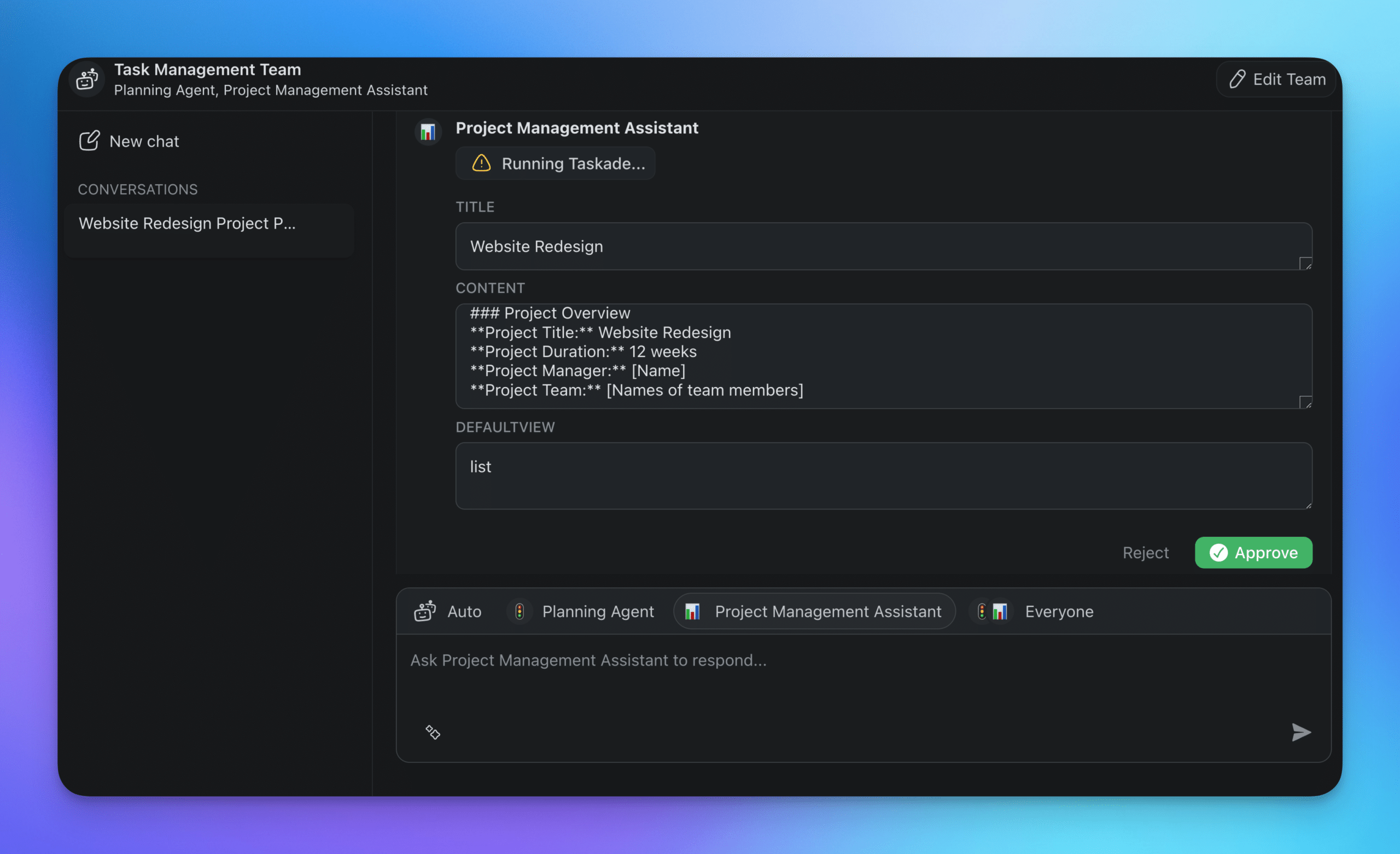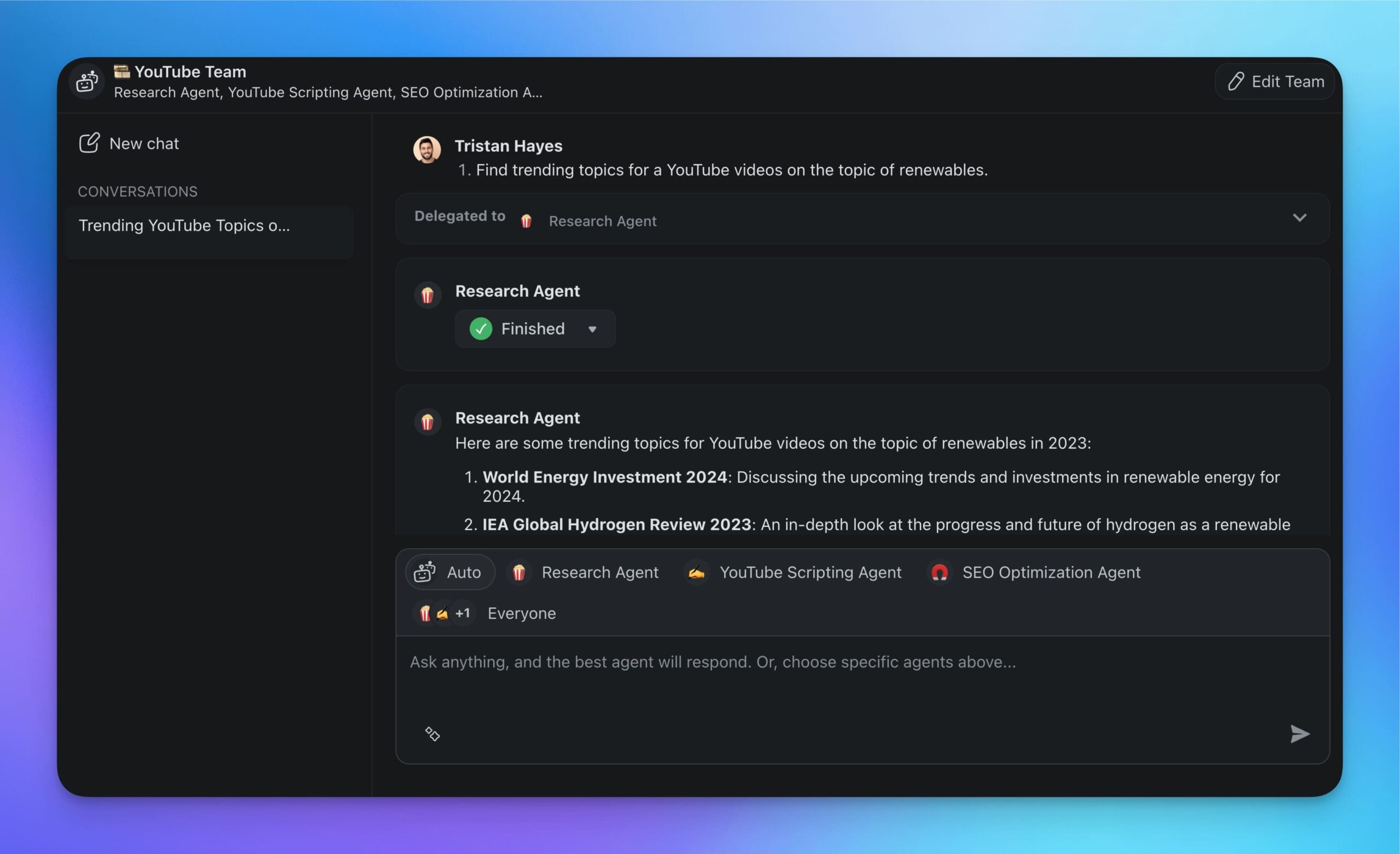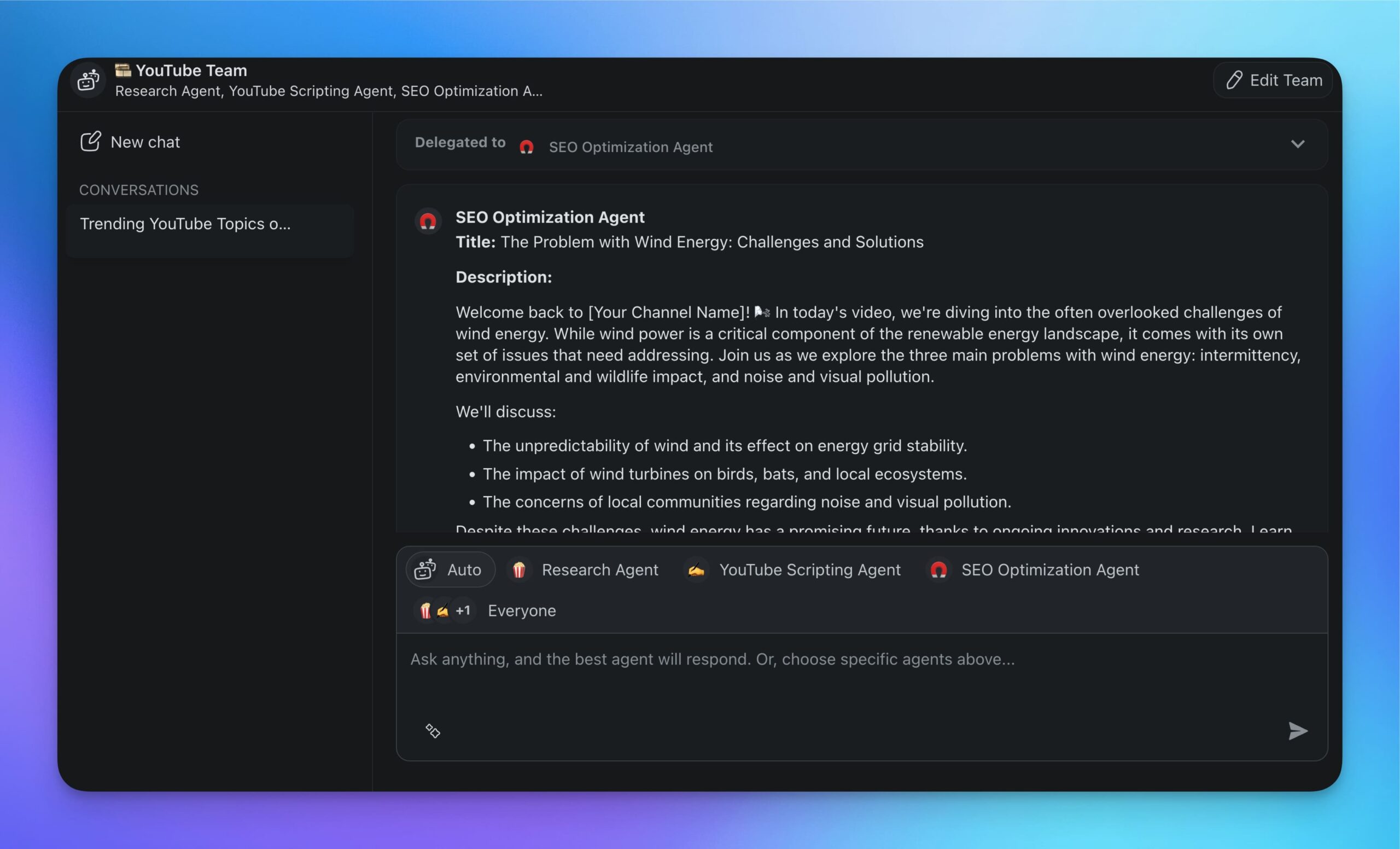AI is everywhere these days, and it makes our lives easier and our businesses more efficient. But when it comes to making the most of AI tools, there is still much grunt work involved. Multi-agent AI teams (or agentic systems) are the paradigm shift in human-AI interactions, and they’re growing fast.
In today’s article, we compare single-agent systems versus multi-agent AI teams. You’ll learn how each of them works and where they fit into your business and personal life. We’ll also show you how you can use Taskade to build, train, and deploy your own AI workforce of the future. 🤖🤖
Psst… New to the topic? Check our article What Are AI Agents? first.
👤 What Is a Single-Agent AI System?
A single-agent AI system is a type of agentic system built on top of one, specialized autonomous AI agent. It can work as a standalone tool or as part of an integrated platform and usually packages additional components like agent knowledge and integrations with external tools.
The main purpose of such a system is to perform tasks independently in self-directed loops. This is a step up from “traditional” prompt-based AI interactions where you continuously feed AI instructions.

Aside from partial autonomy, agentic systems are specialized and can provide more tailored responses than generalized chats with large language models (LLMs) like GPT-4o, Gemini, or Bard. This makes them particularly useful for specific, complex tasks that require a deep understanding of niche topics.
👥 What Is a Multi-Agent AI System?
A multi-agent AI system is made up of several AI agents working together to achieve set goals. Each agent focuses on a specific area within the larger business context, just like in human teams.

Similar to single-agent AI systems, multi-agent setups can tap into a range of external tools and use them as needed to carry out specific tasks. You can also fine-tune each “member” of an AI team with new knowledge using documents, web pages, and other resources for more tailored responses.
So, what makes multi-agent AI systems different?
Unlike simple agentic systems, AI teams can tackle tasks that require adaptive learning, sequential thinking, and enhanced fault tolerance. Since each agent plays a unique role, they can interact naturally, distribute the workload, and hand off tasks in dynamic and complex scenarios.
⚡ Key Differences Between Single-Agent and Multi-Agent Systems
Single agent systems versus multi-agent AI teams — how do these two differ? which is better? Check the table below for a quick overview or scroll down for a detailed comparison.
| Single-Agent Systems | Multi-Agent Systems | |
| 🧩 Complexity | Simple and straightforward. | More complex and dynamic. |
| Ideal for handling specific, ad-hoc tasks. | Consists of multiple unique agents with specialized tools, knowledge, and skills. | |
| Easy to set up, deploy, and maintain. | Suitable for high-level, intricate tasks part of extensive workflows. | |
| 🤹♀️ Flexibility | Operates within a specific area of expertise. | Covers a broader scope with several specialized agents. |
| Functions well as a generalist for specific tasks. | Coordinates multiple agents, each trained on specific subsets of documents and resources. | |
| 📈 Scalability | Not easily scalable. | Reconfigurable and expandable as needed. |
| Requires manual work to repurpose or switch between roles. | Can start with a few agents and grow into a full-fledged team with endless possibilities for expansion. | |
| ⚡️ Performance | Ideal for quick, one-off tasks. | Suitable for complex, ongoing tasks requiring coordination. |
| Faster results due to less setup and tinkering. | Allows for chaining AI outputs, providing accurate and tailored results without user intervention. |
Complexity
Single-agent systems are simple and straightforward. They’re perfect for handling specific, ad-hoc tasks that aren’t tied to larger workflows. Because of their simplicity, they’re easy to set up, deploy, and maintain. Think of them as the go-to solution for quick, isolated jobs.
On the other hand, multi-agent AI systems are more complex and dynamic. They consist of multiple unique agents, each equipped with specialized tools, knowledge, and skills. This setup makes them ideal for tackling high-level, intricate tasks that are part of extensive workflows with many dependencies.
Flexibility
Both single-agent and multi-agent systems are similar in terms of their applications. But there are certain situations where one may perform better than the other.
A single-agent system that has been set up and fine-tuned usually operates within a specific area of expertise. For instance, a Project Management Assistant agent can help with different aspects of project management, including planning, scheduling, or risk management. It’s a generalist at heart.
A multi-agent system covers much more ground. Instead of including one project management assistant agent, it may coordinate several specialized agents like an AI Sprint Planner, Documentation Manager, or a Bug Tracker, each trained on a specific subset of internal documents and external resources.
Scalability
Single-agent AI systems are not scalable. At least not in a convenient way. You can fine-tune and repurpose one agent to serve a different role, but this will take time. You could also set up additional, individual agents and switch between them, but that just means more manual work.
A multi-agent system can be reconfigured and expanded as needed. You can start with just two agents — an SEO Agent and a Copywriter Agent — and then grow this into a full-fledged AI content team by adding a Social Media Agent, a Script Writer Agent, and many more. The possibilities are endless.
Performance
Single-agent AI systems are perfect for quick, one-off tasks like answering questions or generating individual pieces of content. With less setup and tinkering required, you can get results faster. But for complex tasks that require AI team coordination, multi-agent systems are what you’re looking for.
A multi-agent system is the right choice when you want to “chain” AI outputs. For instance, when you ask the AI Copywriter Agent to draft an article, the draft can then be reviewed and refined by the AI Editor Agent without your intervention. You get accurate and tailored results without legwork.
🚀 Benefits of Multi-Agent AI Teams
So, what are the benefits of multi-agent AI? Do they outweigh single agent AI advantages? Let’s find out!
Efficiency and Throughput
Building a single agent for different tasks brings its own set of problems. The most frustrating part of that? The bottlenecks. When an LLM (the brains of the agent) is processing a request, it can’t do anything else. You have to wait for the task to finish before you can prompt it again.
With multi-agent AI systems, you can “delegate” several tasks to agents at the same time, as you would to a human team. Or you can set an overarching objective and let the LLM partition it into bite-sized subtasks. Each task would then be automatically assigned to the most relevant agent.
Check the video below to see how Taskade handles multi-agent collaboration. 👇
Specialized Expertise
Multi-agent systems leverage the strengths of individual agents with deep domain knowledge. Each agent brings a unique, focused perspective to the table it can then share with other agents as needed. This makes agent output more focused, relevant, and precise.
Spreading expertise across a team instead of relying on a single agent also cuts down on AI mistakes or AI hallucinations. When a language model is overloaded with too much information, it’s more likely to spit out errors. But when agents specialize, they can excel in their area of expertise.
Automated Workflows
By design, agents are meant to simplify interactions with artificial intelligence: they minimize the need for constant prompting, reduce the need for follow-ups, and essentially put complex workflows on autopilot. All you need to do is define a goal and kick off the thought process with a single prompt.
The only quirk? You still have to deal with processing the output and feeding it into another agent.
Multi-agent AI systems take this to the next level. You no longer have to babysit each step; one agent passes the baton to the next. Sure, there’s still a human in the loop, but now your job is mostly to sit back and watch. This creates an efficient, seamless, and almost effortless workflow.
🪄 Practical Examples of Multi-Agent Systems
Now comes the big question: “Where do I use multi-agent systems?”
The short answer is “everywhere,” but we can be more specific.
An agentic system with multiple AI agents can help you automate business workflows, optimize supply chains, manage customer service, streamline research, create content, and much more.
Now, let’s look at some real-life examples. 👇
Customer Support Systems
Let’s say you’re running an online store. You’re flooded with customer inquiries — returns, shipping updates, product questions. It’s overwhelming, and you can’t keep up.
Instead of swimming upstream, you can set up an AI dream team to help you out.
First, you can create a support agent trained on descriptions and specs of your entire product lineup. This agent will help your customer reps answer questions and quickly create personalized offers.

This is step one. Step two is covering more ground.
Your support team can set and deploy more agents to handle other aspects of the workflow as needed. For example, a Ticketing Agent can log and categorize issues as they come in. For order-related concerns, an Order Management Agent can track shipment statuses, and so on.
Each specialized agent plays a role. Each saves precious hours. The result? A smoother operation, happier customers, and a more efficient support system that scales with your business.
Automated Task Management
It’s a typical day at the office — you’re starting a new project, and the pressure is on. You’re juggling deadlines and trying to keep your team on track. It feels like too much to handle.
This is where the Planning agent comes in. First, it breaks the project into manageable, bite-sized chunks. Then it outlines each step and defines clear tasks and subtasks.

Once the tasks are defined, the Planning Agent hands off the output to a Project Management Assistant agent which sets up tasks and projects inside a shared workspace.

Want to take it a step further?
You can set up an automation that will use Gmail to send personalized emails to each team member with details of their responsibilities and deadlines. It can also push any updates to a team Slack channel.
The number of agents and automation steps you add to the workflow is up to you. You can build a fully-fledged AI team or keep it lean and organize your agents into small, agile squads.
Content Creation and Curation
Creating any kind of content is a multi-step process. Research, planning, first (terrible) drafts, it’s all part of the process. But you can cut down on a big chunk of the work grunt with an AI team at your side.
Take, for example, recording YouTube videos; the journey begins long before you hit the record button.
First, you need to identify topics that resonate with your target audience. Once you’ve selected a topic, the next step is planning the video, choosing visuals, scripting… You have your work cut out for you.
Let’s try to build an AI team to simplify the process.
Start with the Video Research Agent. It will help you find trending topics that your audience will love.

Next, the Scripting Agent will analyze the topic and write a script that grabs attention and keeps viewers engaged. The Scene Planning Agent will then take the script and lay out your video.

Finally, the SEO Optimization Agent steps in. It will analyze the video you’re working on and add the right keywords and descriptions to ensure your video gets seen by the right audience.

Choosing the Right AI System for Your Needs
Time to wrap this up.
We’ve gone through the core mechanics of multi-agent AI systems, explained their benefits, and explored a handful of use cases you can try using Taskade’s AI Teams feature.
Let’s recap everything we’ve learned today:
- ✨ Multi-agent AI systems consist of multiple specialized agents working together.
- ✨ They enable AI agent collaboration and seamless communication between agents.
- ✨ Agentic systems can easily be expanded and reconfigured with additional tools and knowledge.
- ✨ Multi-agent setups leverage the specialized knowledge of individual agents.
- ✨ Autonomous task management in multi-agent systems enables seamless task transition.
- ✨ Multi-agent systems enhance precision by using agents with deep domain expertise.
- ✨ Multi-agent cooperation is the focus of agentic architecture.
And that’s it. Building a team of AI agents is easier than you think, if you have the right tools. Set up yours with Taskade AI in under 5 minutes and put your workflow on autopilot.
P.S. Want to learn more about agentic architecture? Read What Are Multi-Agent Systems? next.




 What Is AI as a Service (AIaaS)? Types, Benefits, and Challenges
What Is AI as a Service (AIaaS)? Types, Benefits, and Challenges  Taskade’s Top 5 AI-Powered Features Transforming the Future of Work
Taskade’s Top 5 AI-Powered Features Transforming the Future of Work  Top AI Chatbots for Complex Tasks: Enhancing Productivity with Taskade’s AI Features
Top AI Chatbots for Complex Tasks: Enhancing Productivity with Taskade’s AI Features  Agentic Workflows: Paving the Path Towards AGI
Agentic Workflows: Paving the Path Towards AGI  Exploring ChatGPT Models: A Look at Every Release Version
Exploring ChatGPT Models: A Look at Every Release Version  Top AI Prompt Generators to Elevate Your AI Workflows
Top AI Prompt Generators to Elevate Your AI Workflows